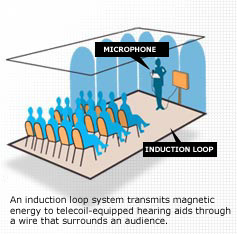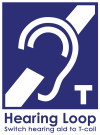Raleigh Little Theatre is pleased to announce the Cantey V. Sutton Theatre now has a hearing loop installed for the hard of hearing. The induction loop was installed with the generous support of The Jandy Ammons Foundation, North Carolina Audiology Associates, Siemens Corporation, and The City of Raleigh.

From hearingloop.org
The hearing loop is available for all shows and events that are held in the Cantey V. Sutton Theatre.
To tune into the loop set your hearing aid to the T-coil program. If you do not know how to do this check with your audiologist; most hearing aids have this function but it may need to be activated by your audiologist.
If you do not have a hearing aid, or your hearing aid does not have a T-coil, RLT has a limited number of headphone units available on a first come, first serve basis. Please request one from the house manager or from the box office.
Frequently asked questions
Prepared by Hearing Loss Association of America – Wake Chapter
- What is an audio loop? An audio loop consists of hidden wires around an area driven by an amplifier that varies an electrical signal to the loop, which then broadcasts an invisible magnetic signal that can be received by an inductive coil (telecoil) in some hearing aids, cochlear implants (CIs) or “loop receivers”. The RLT loop is a professionally installed “Phased Array” loop that provides even better hearing than the simple loop illustrated at the right.
- What is a telecoil? It’s a tiny coil of wire that induces an electrical current representing sound when it senses a variable magnetic field. It can be used to hear sounds represented by that magnetic field. It can be used with or instead of your hearing aid’s (or CI’s) microphones. Telecoils can get a clear audio signal directly into your hearing device.
- How do I know whether I have a telecoil? About 70% of hearing aids and all recent cochlear implants have telecoils. Ask your audiologist or hearing aid dealer.
- How do I know if it’s been activated and set to my needs? Ask your audiologist or hearing aid dealer.
- What are my telecoil programming options? Most hearing aids have multiple programs that you can switch to for different hearing environments. Usually that includes one for quiet, and one for noisy situations, and others you can choose what to program them for. You could set one program to only listen to your telecoils (and turn off your microphones). That will avoid your hearing any background noise. If background noise isn’t a big problem for you, you could set one program to hear some percentage of both your microphones and your telecoils. It’s a personal choice your audiologist or hearing aid dealer can help you with.
- How do I switch to telecoil mode? Most hearing aids have a button that you can use to toggle through your programs to choose the program you want to use. Some hearing aids come with a remote control that can go directly to the program you want. Some hearing aids automatically change programs based on what they hear. Your audiologist or hearing aid dealer can explain how your’s work.
- If I don’t have telecoils? Raleigh Little Theatre has Loop Receivers and headphones you can borrow. This can work for people without hearing aids and for some with hearing aids that don’t have telecoils. If your hearing aids feedback when using headphones, you may be able to use a Loop receiver and headphones if you take your hearing aids out.
- If I don’t have telecoils, how can I get them? Telecoils can be added to some hearing aids if they don’t have them. But the best way is to always make sure the next hearing aids you buy come with telecoils, and demand that they be activated and set to your needs … and that you are trained how to switch into and out of telecoil mode.
- Are telecoils expensive? Most hearing aids come with telecoils for no extra cost. If telecoils have to (and can) be added, the cost is relatively low.
- What can I use my telecoils for?
- Most telephones are telecoil compatible.
- You can install your own personal loop in your TV room so you can hear the TV better.
- Most personal assistive listening devices and transmitters/receivers can allow you to use a personal “neckloop” to hear audio sources like microphones, iPods, smart phones (for music or podcasts), and TVs.
- Most museums will loan or rent telecoil compatible “wand”players that guide you through and explain the exhibits.
- Most headphones are telecoil compatible.
- Most movie theaters will loan you a receiver that can use a neckloop that lets you hear the movie better.
- Some churches are looped; most churches have Assistive Listening Devices that include neckloops/headphones).
- NC Museum of Art SECU Auditorium is looped, and an FM system with neckloops/headphones is available for tours.
- How can I find ALD and Looped facilities?
- They should display a sign like the image shown below.
- aldlocator.com shows facilities that have Assistive Listening Devices in general.
- looplocator.org shows facilities that are looped.
- How can I learn more about hearing better?
- Join Hearing Loss Association of America, HLAA, (hearingloss.org).
- Get involved with a local HLAA local chapter (find chapters at: hearingloss.org/support_resources/find-local-hlaa-chapter).
- For more information about loops: nchearingloss.org/Loops.pdf.

For more information
- Learn about hearing loops and T-coils
- The RLT loop was installed by American Hearing Loop
- Read more at hearingloop.org, a non-profit organization
- Call our box office at 919-821-3111